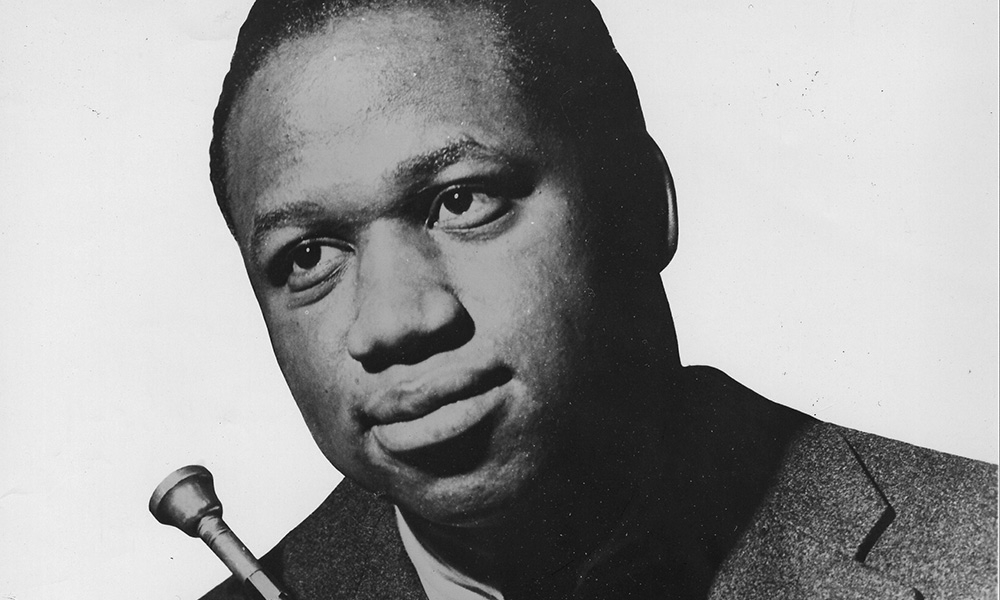[cmsmasters_row][cmsmasters_column data_width=”1/1″][cmsmasters_text]

Photo: Gilles Petard/Redferns
Clifford Brown was only 25 when he died in a car accident in 1956, yet the rich body of work he left behind sealed his reputation as one of the greatest trumpet players who ever lived. Quincy Jones even described Brown as one of the most important musicians of all time. “I believe that a hundred years from now, when people look back at the 20th century, they will look at Miles Davis, Charlie Parker, Clifford Brown, Ella Fitzgerald, and Dizzy Gillespie as our Mozarts, our Chopins, our Bachs, and Beethovens,” Jones told New Orleans Public Radio in 2013.
Musical Beginnings
Clifford Benjamin Brown was born in Wilmington, Delaware, on October 30, 1930, the youngest of eight children in a musical family that included his opera singer sister, Geneva. Brown started on trumpet at the age of 13. “From the earliest time, I can remember it was the trumpet that fascinated me,” Brown told jazz critic Nat Hentoff. “When I was too little to reach it, I would climb up to where it was, and I kept knocking it down.”
Brown gave few broadcast interviews in his life, but in one conducted in 1956 by Willis Conover for Voice of America, Brown said his main influences were trumpeters Fats Navarro, Louis Armstrong, and Roy Eldridge. “There is always ‘Pops’, Louis Armstrong, the father so-to-speak, and I was very inspired by Roy Eldridge’s playing on ‘Let Me Off Uptown,’” recalled Brown.
Recovering From A Car Crash
Although Brown studied as a mathematics major at Delaware State University, he had his heart set on a career in music. He even overcame an automobile disaster in 1950 on his way to fulfilling that dream. On June 3, 1950, in a macabre foreshadowing of his later fatal accident, 19-year-old Brown accepted an early morning lift home from a gig at a house party in Maryland. After the driver swerved to avoid hitting a deer, the automobile overturned and two of the fellow musician passengers were killed. Brown was severely injured, suffering broken bones in both legs, and a fracture in his torso. He needed skin grafts all over his damaged body.
Brown always spoke of his gratitude towards trumpeter Dizzy Gillespie, who visited Brown during his recovery and insisted that he had to return to playing one day. Although problems with his shoulder socket made supporting the trumpet almost impossible in the early months, he gradually returned to playing music by practicing at the piano. It says so much for his fortitude that Brown, who was on crutches for months, also began to play the trumpet again during a difficult convalescence at his parents’ home.
By March 1952, Brown was well enough to play in his first recording session – with Chris Powell and His Blue Flames – and he became almost zealous in his devotion to practice. The esteemed Blue Note saxophone player Lou Donaldson, who recorded and toured with Brown at this time, recalled that the trumpeter would be perfecting his skills all day, even at six o’clock in the morning on a tour bus. “We would have breakfast and Clifford would practice… he would do lip exercises and mouth exercises all day,” Donaldson told Jazz Wax.
Brown himself always said that “the most important thing” a jazz musician could do was train away from the stage. Donaldson said all the hard work strengthened Brown’s lips and enabled him to play three sets a night and still be firing after hours on stage.
In May 1952, Brown got the chance to sit in with Charlie Parker for a week at Club Harlem in Philadelphia. “Bird helped my morale a great deal,” Brown later told Hentoff. “One night he took me in a corner and said, ‘I don’t believe it. I hear what you’re saying, but I don’t believe it.’”
Listen to Clifford Brown on Apple Music and Spotify.
The Golden Era
Word soon spread about the trumpet prodigy’s talent and over the next 18 months, Brown played with Lionel Hampton’s band and Art Blakey’s Quintet, with whom he recorded his debut album for Blue Note called New Star On the Horizon. Brown also recorded with Jay Jay Johnson for Blue Note and appeared on “A Study in Dameronia” with Tadd Dameron for Prestige Records.
When singer Sarah Vaughan heard him play, she told Powell, “I have to have Clifford for a record date.” She persuaded him to record with her on the EmArcy Records album Sarah Vaughan (sometimes referred to as Sarah Vaughan with Clifford Brown), which is considered a classic and was inducted into the Grammy Hall of Fame in 1985. Flute maestro Herbie Mann, who also played on the album, told Brown’s biographer Nick Catalano that joining the young trumpet player in the studio was a “defining moment” for him. “Playing alongside Brownie was like being on a basketball court with Michael Jordan,” said Mann. Brown’s sublime use of mutes is just one of the many delights of an album that shows off his technique for playing long, flowing melodic lines and solos that shine with great feeling.
Another key album is the 1955 EmArcy record Study in Brown, which features the trumpeter with drummer Max Roach and pianist Richie Powell, the younger brother of Bud Powell. Brown had moved out to Los Angeles by this time and had been working hard on composing. The record contains versions of his own tunes “Swingin’,” “George’s Dilemma,” “Sandu,” and “Gerkin for Perkin.” The album also contained a superb version of Ray Noble’s “Cherokee.” Brown would have been honored to know that his idol Louis Armstrong kept a well-worn copy of the album in his music library and made notes about Brown’s music.
How Clifford Brown Helped Sonny Rollins
“People did talk about him being a brilliant mathematician,” said Don Glanden, Head of Graduate Jazz Studies at Philadelphia University and the man who made the documentary Brownie Speaks. “Quincy Jones talks about him being able to calculate exchange rates for the band in his head when they were touring Europe with Lionel Hampton,” added Glanden.
While he was making all his magnificent albums, Brown was happily married to Larue Brown Watson, whom he met in 1954. He wrote a song for her called “LaRue,” which he performed to her on Santa Monica beach before proposing. “It’s a beautiful slow ballad. It was never recorded by my grandfather,” said trumpeter Clifford Brown III in 2018, “because he lost the privilege of recording this very special song to his good friend trumpeter Kenny Dorham in a chess match.”
Brown wasn’t a drinker or smoker, and his clean-cut attitude had a profound influence on Sonny Rollins when the tenor saxophone maestro replaced Harold Land in the band in December 1955. Rollins joined after a spell in a rehabilitation hospital for substance abuse. “When I came across Clifford it was ‘Wow, this guy can play so much music, and yet he’s clean living’… he ended up being a perfect model – such a light to me,” Rollins told critic Stuart Nicholson.
Brown’s biographer Catalano put it simply: “No one in jazz ever had a bad word to say about Clifford Brown. Art Farmer was pitted against Clifford on the Lionel Hampton tour and even though there were these trumpet duels that Hampton forced them into night after night, Art said that even though he was scuffling for his life, he could never think of anything but respect, admiration, and real love for Clifford because he was such a wonderful person.”
Brown’s Tragic Early Death
Benny Golson, who went on to compose the timeless ballad “I Remember Clifford” – which has since been recorded by Donald Byrd, Ray Charles, and Gillespie – remembered in vivid detail the shocking events of June 27, 1956. Golson’s gig with Gillespie’s band at the Apollo Theatre was interrupted by pianist Walter Davis Jr running on stage and shouting, “You heard? You heard? Brownie was killed. He was killed in a car accident!” Golson recalled that the band remained frozen in shock for an age.
Brown had been in the car with Richie Powell and his wife Nancy, who was driving the musicians from Philadelphia to Chicago to meet up with Roach for the band’s next appearance. While on the Pennsylvania Turnpike, Nancy lost control of the car on a wet stretch of road, hit a bridge abutment, and rolled down a 75-foot embankment. All three passengers were killed instantly.
Brown’s Lasting Legacy
The Clifford Brown Festival, which is held in Wilmington each year, is just one way that the legacy of the trumpeter lives on. Brown influenced a generation of musicians, including Freddie Hubbard, Lee Morgan, and Wynton Marsalis. Hubbard spent three years studying Brown’s music while at Jordan Conservatory, and Morgan was lucky enough to have taken lessons from Brown directly.
Donald Byrd said that all trumpeters can learn from Brown’s technique and unrivaled ability to create beautiful modulations on the melody. “Clifford created a vocabulary that I and everyone since then has adopted,” Byrd told Down Beat.
Brown also left some intricate, well-thought-out compositions, which have become standards, including “Sandu.” His tune “Daahoud” was a particular favorite of Gillespie’s, while Stan Getz always raved about “Joy Spring,” cutting his own version for Concord in 1981.
Although Brown’s time on earth was fleeting, his lasting impact on jazz history and trumpet playing is indelible. Sadly, we will never know just how good he would have become. According to the biography Little Jazz Giant, Brown’s hero Roy Eldridge said, after hearing about the youngster’s death, “I just liked the way Clifford blew his horn. As good as he was, he was going to be better.”
Listen to Clifford Brown’s trumpet playing on recent reissues in the Acoustic Sounds series.
[/cmsmasters_text][/cmsmasters_column][/cmsmasters_row]



